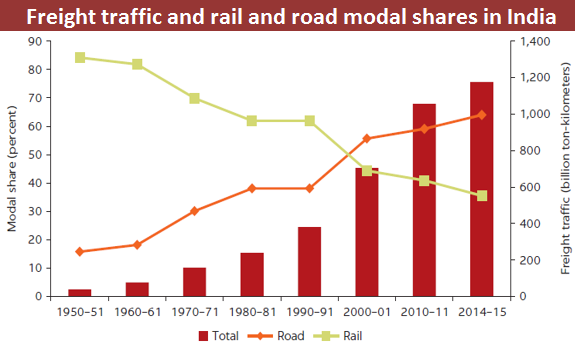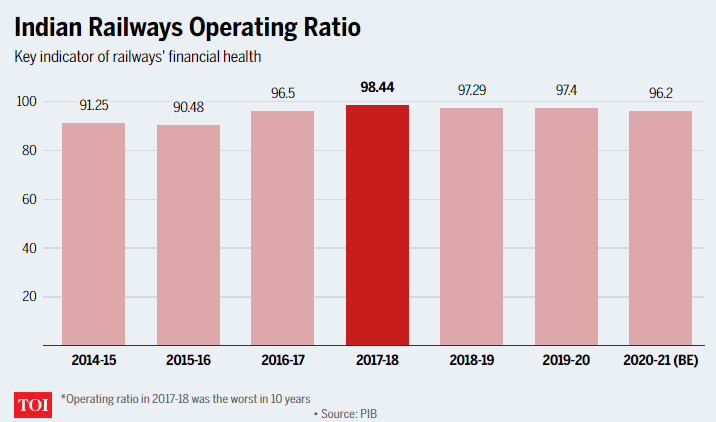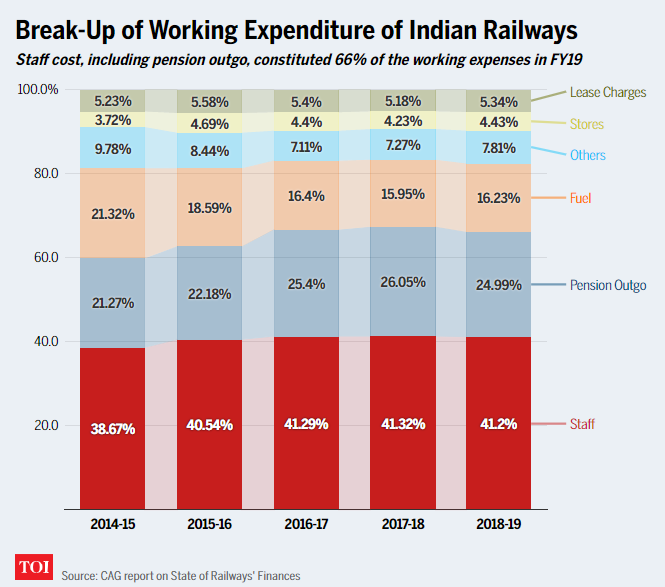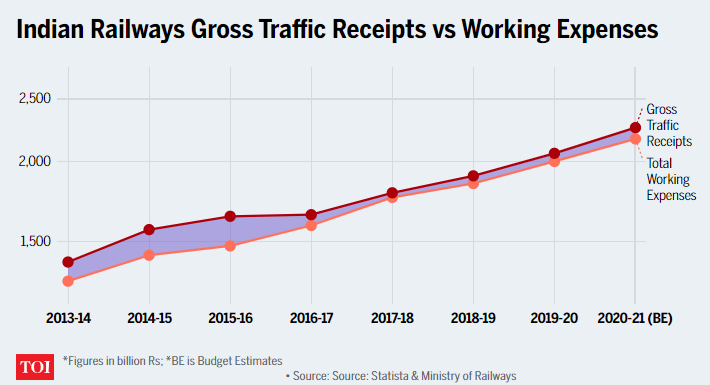REIMAGINING INDIAN RAILWAYS
2022 MAR 22
Mains >
Industry and infrastructure > Infrastructure & Investment models > Railways
INDIAN RAILWAYS:
History:
- The history of Indian Railways formally started on 16th April 1853, when the first passenger train ran between Bori Bunder (Bombay) and Thane.
- The early era was primarily funded by private companies under a guarantee system created by the British Parliament, which ensured that they would receive a certain rate of interest on their capital investment.
- Following the Revolt of 1857 and the subsequent liquidation of the East India Company, the British Raj took control of railway construction and increased expansion to help areas struck by famine.
- World War I took its toll on Indian rail development. Railway finances were separated from the general budget in 1924. The economic depression of 1930s and World War II further stymied railway development.
- In 1947, following the partition, more than 40% of the railway network was lost to the newly created Pakistan.
- Since then, Indian Railways has made steps towards expansion and modernization, which included modern trains, electrification of lines, development of metros and development of online facilities.
Present status:
- Today, the Indian Railways is the country’s largest transporter and employer. It stands second in the world in passenger movement and fourth in freight movement.
- At the end of fiscal year 2021, the length of railway routes across India was over 68 thousand kilometers, plying 23 million travelers and 3 million tonnes of freight daily from 7349 stations.
- The Railways is headed by a seven-member Railway Board.
- Indian Railways divides its operations into zones.
- It also owns various subsidiaries related to rail transport, such as IRCTC, Dedicated freight corridor corporation, Integrated Coach factories and locomotive units.
- Railways is financed through:
- Its own internal resources
- Budgetary support from the central government
- Extra budgetary resources such as borrowings, public private partnerships, and foreign direct investment.
- Railways’ working expenses (salaries, pension etc.) are met through its internal resources. Capital expenditure is financed through borrowings, budgetary support from central government and Railways’ own internal resources.
SIGNIFICANCE OF INDIAN RAILWAYS:
- Social:
- Since the era of freedom struggle, railways have been a strong medium of national integration.
- Today, railways are the lifeline of India, providing the cheapest mode of transport, facilitate rural-urban connectivity and act as a channel of migration within the country.
- Economic:
- Railways is the largest employer in the country. Also, presence of rail lines is a key driver of economic growth, as it facilitates faster and cheaper bulk cargo transport.
- Eg: Growth of textile industry in Mumbai, jute industry in Kolkata and coal industry in Jharkhand are largely credited to the connectivity provided by the railway network.
- Defence:
- Railways facilitates rapid movement of troops and defence equipment across the country. This was vital on many occasions, such as the 1971 war, where railways played a key role in ensuring that India’s military capability remained well-supplied at the Eastern and Western fronts.
- Strategic lines:
- Strong rail connectivity is key for India to secure its interests in strategic areas, such as along the LAC and the Northeast. This is why India is developing infrastructure such as the 111 km-long new Imphal-More broad-gauge rail line, Bogibeel bridge and Dhola–Sadiya Bridge.
- Crisis management:
- Railways play a vital role in the management of calamities such as droughts, floods, earthquakes and social unrests.
- Eg: In 2016, ‘water trains’ were used to carry water to meet the severe droughts in Latur in Maharashtra.
- Eg: During the COVID pandemic and lockdowns, the Indian Railways ran Kisan Rail services to transport agricultural produce & perishables.
- Sustainable development:
- According to ‘The Future of Rail’ report (released by the International Energy Agency (IEA)), while the railway carries 8% of the world’s passengers and 7% of global freight transport, it represents only 2% of total transport energy demand. Hence, the rail sector can provide substantial benefits for the energy sector and for the environment.
ISSUES WITH INDIAN RAILWAYS:
I. SERVICE DELIVERY:
- Quality:
- Indian Railways is riddled with issues of poor quality in services delivered. Various CAG reports have rapped the Railways about the poor quality of meals served on board and management of linen used in the trains.
- Safety:
- Over the years, India has witnessed a series of rail accidents. The Bikaner-Guwahati Express train accident at West Bengal in 2022, Seemanchal express accident in 2019 and Hirakhand Express accident in 2017 are some of the examples.
II. ADMINISTRATION:
- Dilemma of identity:
- The Indian Railways suffers from a dilemma of identity: is it a commercial entity or a government department trying to work on commercial principles?
- Monopoly:
- The government is the sole player in the rail transportation system in India. Thus, the lack of any competition has created poor quality service delivery and inefficient management of the system.
- Centralised:
- Currently, the Railway Board has the powers of policy making, operations, and regulation, while zones have very limited powers with regard to raising their own revenue. Therefore, they are unable to contribute more effectively towards improving Railways’ revenue.
- Non-core functions:
- Apart from its core function of running trains, Railways is also engaged in several un-remunerative peripheral activities such as running schools, and hospitals, staff housing, catering, and security. This imposes a huge financial burden on Railways.
- Recruitment:
- Railways did away with the decades old system of recruiting officers to the eight ‘Group A’ services and instead have recruitments to a single service called the Indian Railways Management Service (IRMS). However, there is a nearly 40% reduction in the cadre strength.
- Also, the recruitment would be made through the Civil Services exam, which does not measure the technical competence which is needed in Railways.
- Political involvement:
- Indian Railways has often been used as a tool for political patronage, especially during poll years. Due to this, several economically inefficient initiatives and projects were established in the past.
III. FINANCIAL:
- Cross subsidy:
- Railway is cheaper compared to road routes in India (at the rate of Rs. 2/ton-km for freight and Rs. 1.6/passenger-Km). However, cross subsidy has become counterproductive by driving away freight business, thereby affecting the internal revenue generation of the Railways.

- Operating inefficiency: ()
- The Indian Railways has an operating ratio of 98.44%, which indicates its dire state. As much as 60% of Indian Railways lines are utilised beyond its 100% capacity. Large number of delayed and stranded projects adds to this stress.

- High revenue expenditure:
- Railway is the only “earning” department/Ministry of the Government that fully meets the salary, and (till recently) the pension obligations out of its own earnings. The Eighth Pay Commission, normally due by around 2025-26, is bound to strain finances further.

- Heavy reliance on budgetary support:
- In the last few years, the growth of Railways’ transportation business has been declining, and consequently, its ability to generate its own revenue has been on a decline. Hence, Railways’ dependence on budgetary support for capital expenditure has been on the rise.

- Self-sufficiency vs social obligation:
- Indian Railways is caught up between making it a self-sufficient organisation and serving its social obligation as a poor man’s mode of transport. It is unable to raise passenger fares to viable levels, while being forced to run new trains and routes along commercially unviable routes.
IV. EXTERNAL:
- Competition from other modes:
- The cost of a flight ticket between major cities has become nearly equal to that of a second-class AC train ticket. Also, timeliness and better service delivery makes people prefer flights over trains for longer journeys.
- The share of roads in freight transport is more than half in India. As more highways are getting built rapidly, the competition from roads in freight transport is increasing at an accelerating rate.
- Impact of emphasis on sustainable development:
- The push for renewable is bound to have an impact on India’s coal Industries. The Railways is particularly vulnerable because around half of the freight traffic comes from carrying coal.
WAY FORWARD:
In 2015, the Indian Railways had set up the Bibek Debroy Committee on Restructuring of Indian Railways. The committee had made some key recommendations, which include:
- Split the three roles of Railways:
- Policy making, to be kept within government control.
- Regulation, to be entrusted with an independent body to ensure a fair playing ground for all entities.
- Operations: The core functions can be privatized or corporatized, while peripheral function must be privatized.
- Encourage Private entry: in running both freight and passenger trains in competition with Indian railways
- Railway Regulatory Authority of India (RRAI): Establishment of an independent regulator to ensure fair and open access, establish tariffs and adjudicate disputes.
- Establish Indian Railway Manufacturing Company to manage all the production units.
- Focus on core activities: Indian Railways should focus on core activities & distance itself from non-core.
- Investment Advisory Committee: consisting of experts, investment bankers and representatives of SEBI, RBI, IDFC and other institutions to recommend raising new resources.
- Refinements in the way Indian Railways prepares and maintains accounts, costs, activities and services, recruitment & HR processes
- Decentralisation of Railways.
Besides these, the Committee for rationalisation of government bodies and proposal for the Ministry of Railways has called for major reforms in the Indian railways such as closure of major establishments, merger of decades-old organisations and private participation in running of its schools and hospitals
RESTRUCTURING RAILWAYS: EXAMPLES FROM OTHER COUNTRIES
Several countries have restructured their Railways. Most of it has been on the lines of segregating bodies on the basis of their functions, and creating autonomous bodies that are independent of the government.
- Japan privatised its railway system in 1987. Based on geographical demand, Japanese railway system was divided into six regional passenger railway companies, and one nationwide freight carrier. Each company would make its own decisions on which lines to operate and which ones to close.
- In China, restructuring reforms have included the splitting of freight, passenger and network management businesses into independent divisions. Several freight and passenger companies have been created including three specialist freight companies dealing with container, express cargo, and special cargo. Non-core activities such as construction, manufacture, education and other social activities have been separated, and are being provided on a tendered basis.
- In the UK, the railway system was privatised in 1993. Railways was separated into 25 train operation units known as train operating companies, which were privatised by a franchising process. A rail regulator was appointed with powers to grant operating licenses, enforce compliance with those licenses, and authority to regulate access to tracks, stations, and depots.
PRACTICE QUESTION:
Q. Indian Railways need a major overhaul if it is to maintain its significance in the coming decades. In this regard, discuss the issues faced by railways and suggest solutions?



